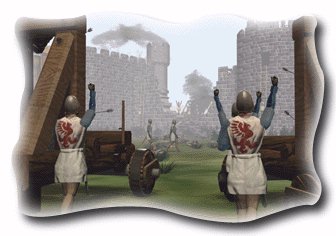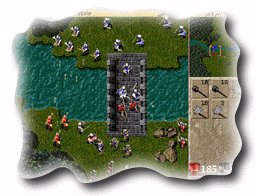

Film at 11: We had a chance to go visit and speak with David Lester, founder of Impressions now part of the Sierra family. David shared with us his design concept for the games he was working on. A Betacam SP film of Davidís interview was edited and broadcast as a segment of The Computer Show as part of our regular programming. Much of the information below came from the time we spent with Dave talking and looking at the new game.
History: Just a short two years ago, the original Lords of the Realm was released, which captured critical acclaim from a wide range of gamers. The current game expects to capture the same audience with a real-time strategy game. Similar to the original game, the setting is medieval times, 1268 A.D. to be precise. The location is England, where the goal is to become the king. Starting out as a lord, game play requires unifying people under your leadership, increase the resources of cattle, grain, wood, gold, iron, and others that will assist in the building of castles, armies, and siege engines.
Interface: The main screens include a top down perspective map of England divided into noble fiefs and top down maps of villages complete with castles, farms, and other sim city like building projects. As the game progresses, animated sequences, called cut scenes, will portray certain important events, such as a unit of archers hurling arrows at an oncoming enemy.
Gameplay: You need develop your realm, grow crops, raise livestock, mine and quarry iron and gold, manage a forestry operation, build weapons, hire and manage stewards to tend your castle, hire and manage caretakers to tend your farms, raise an army, build castles, and carry on diplomacy. Just so you will not be performing the same old successful strategy taking one neighboring fief after another, Sierra will be mixing things up by making the game more difficult the more successful you are, forcing you to develop new strategies.
Of course there were many people who did not feel that the game was
repetitive, and they enjoyed taking land after land relying on time
honored tactics honed in battle after battle. There is also the
possibility of going to far, just as Might and Magic II did when they
increased difficulty proportional to level attainment. The game was
actually easier to play on lower levels and character development worked
against you more than any other factor in the game.

Difficulty: The difficulty level determines the amount of control that the player has over the game. In novice there is less for the game player to do, while in veteran the level of micro management is more intense.
Interface: The strategic game is turn-based and carried on an overhead, third person, isometric perspective map that shows mountains, forests, and other terrain on diamond shaped tiles on the left three fourths of the screen. The right one-fourth screen size panel has a map of jolly old England at the top with fifteen color coded realms. The version we saw had six players: blue, purple, violet, green, yellow, and red. Below the country map are the command and information screens that provide information and control to selected units.
A zoomed rotatable overhead oblique view shows color-coded armies, castles, farms, taverns and other structures in high detailed relief on the map. It appears that individual squares or diamonds have preset structures, but the castle requires custom building techniques, perhaps like the Interplay Castles game. Hopefully, the structures will upgrade with money, time or other factors.
Combat: Jumping on the C&C, Warcraft, and other games of the same ilk bandwagon, the combat mode and siege-mode is real-time. Six different unit types will be at your disposal: peasant peons, mounted knights, swordsmen, pike men, crossbow men, archers, and mace men. Castles will now store gold so their building and defense will be a crucial part of the game. Since underlying the entire game is the economic game, mining and protecting gold will be very important. Sieges will use siege engines, distance weapons, boiling oil, army units, and other individually controlled units.
Graphics: The zoomed in map graphics show individual units of men that vary in number of individual men shown based upon army or unit strength. Each army will wear color coded uniforms to distinguish which army they are, and the rendered characters will be holding bows if archers, riding horses if mounted knights, and wielding pikes if pike men, to name a few of the graphic refinements.
Artificial intelligence: ?
Voice actors: ?
Musical score: ?
Sound effects: ?
Multiplayer features: ?
Utilities: ?
Previews references:
InterAction, summer, 1996, pg. 42-43
Next Generation Magazine, volume 2, June, 1996, pg. 86.
Scott Udell, Computer Games Strategy Plus, issue 90, September, 1996,
pg. 46.